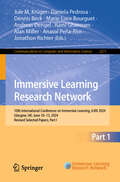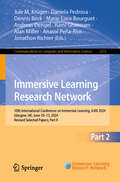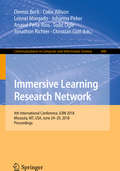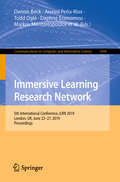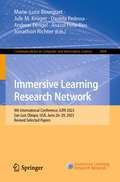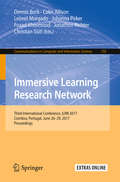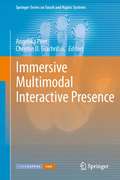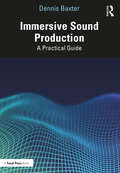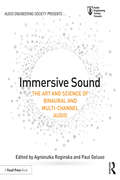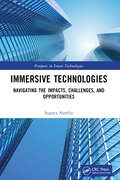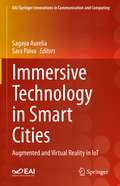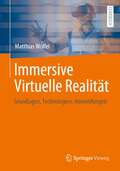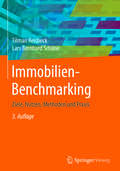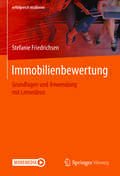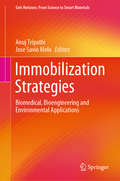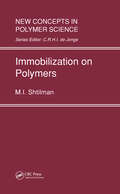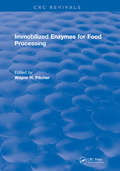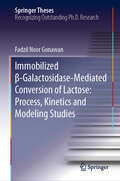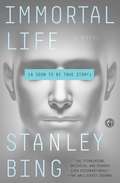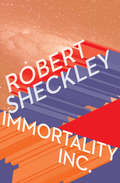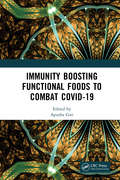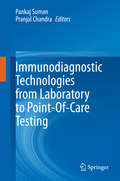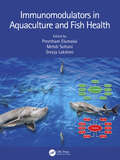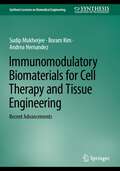- Table View
- List View
Immersive Learning Research Network: 10th International Conference on Immersive Learning, iLRN 2024, Glasgow, UK, June 10–13, 2024, Revised Selected Papers, Part I (Communications in Computer and Information Science #2271)
by Dennis Beck Jonathon Richter Alan Miller Anasol Peña-Rios Andreas Dengel Rami Ghannam Marie-Luce Bourguet Jule M. Krüger Daniela PedrosaThis book constitutes the proceedings of the10th International Conference on Immersive Learning, iLRN 2024, held in Glasgow, UK during June 10–13, 2024. The 30 full papers and 13 short papers presented in this volume were carefully reviewed and selected from 144 submissions. They were categorized under the topical section as follows: Part I: Foundations in Immersive Learning Research and Theory; Assessment and Evaluation (A&E); Galleries, Libraries, Archives and Museums (GLAM); Inclusion, Diversity, Equity, Access, and Social Justice (IDEAS); STEM Education (STEM); Medical & Healthcare Education (MHE); Workforce Development & Industry Training (WDIT); Self and Co-regulated Learning with Immersive Learning Environments (SCILE). Part II: Special Track 1: Immersive learning across Latin America: State of Research, Use Cases and Projects; Special Track 2: Sustainable Development and Immerse Learning in the Climate Emergency; Special Track 3: Literacy Equity and Immersive Learning.
Immersive Learning Research Network: 10th International Conference on Immersive Learning, iLRN 2024, Glasgow, UK, June 10–13, 2024, Revised Selected Papers, Part II (Communications in Computer and Information Science #2272)
by Dennis Beck Jonathon Richter Alan Miller Anasol Peña-Rios Andreas Dengel Rami Ghannam Marie-Luce Bourguet Jule M. Krüger Daniela PedrosaThis book constitutes the proceedings of the10th International Conference on Immersive Learning, iLRN 2024, held in Glasgow, UK during June 10–13, 2024. The 30 full papers and 13 short papers presented in this volume were carefully reviewed and selected from 144 submissions. They were categorized under the topical section as follows: Part I: Foundations in Immersive Learning Research and Theory; Assessment and Evaluation (A&E); Galleries, Libraries, Archives and Museums (GLAM); Inclusion, Diversity, Equity, Access, and Social Justice (IDEAS); STEM Education (STEM); Medical & Healthcare Education (MHE); Workforce Development & Industry Training (WDIT); Self and Co-regulated Learning with Immersive Learning Environments (SCILE). Part II: Special Track 1: Immersive learning across Latin America: State of Research, Use Cases and Projects; Special Track 2: Sustainable Development and Immerse Learning in the Climate Emergency; Special Track 3: Literacy Equity and Immersive Learning.
Immersive Learning Research Network: 4th International Conference, iLRN 2018, Missoula, MT, USA, June 24-29, 2018, Proceedings (Communications in Computer and Information Science #840)
by Colin Allison Leonel Morgado Johanna Pirker Dennis Beck Jonathon Richter Christian Gütl Anasol Peña-Rios Todd OgleThis volume constitutes the refereed proceedings of the 4th International Conference of the Immersive Learning Network, iLRN 2018, held in Missoula, MT, USA, in June 2018. The 12 revised full papers and the two revised short papers presented in this volume were carefully reviewed and selected from 57 submissions. The papers are organized in topical sections on environmental sciences, climate change, immersive technologies; immersive technologies in cultural heritage; immersive technologies in primary and secondary education; games and game design.
Immersive Learning Research Network: 5th International Conference, iLRN 2019, London, UK, June 23–27, 2019, Proceedings (Communications in Computer and Information Science #1044)
by Leonel Morgado Johanna Pirker Dennis Beck Jonathon Richter Christian Gütl Anasol Peña-Rios Todd Ogle Daphne Economou Markos Mentzelopoulos Christian Eckhardt Roxane Koitz-Hristov Michael GardnerThis volume constitutes the refereed proceedings of the 5th International Conference of the Immersive Learning Network, iLRN 2019, held in London, UK, in June 2019.The 18 revised full papers and presented in this volume were carefully reviewed and selected from 60 submissions. The papers are organized in topical sections on science, technology, engineering, and mathematics (STEM); disciplinary applications: special education; disciplinary applications: history; pedagogical strategies; immersion and presence.
Immersive Learning Research Network: 9th International Conference, iLRN 2023, San Luis Obispo, USA, June 26–29, 2023, Revised Selected Papers (Communications in Computer and Information Science #1904)
by Jonathon Richter Anasol Peña-Rios Andreas Dengel Marie-Luce Bourguet Jule M. Krüger Daniela PedrosaThis volume constitutes the refereed proceedings of the 9th International Conference of the Immersive Learning Network, iLRN 2023, held in San Luis Obispo, USA, in June 2023 as a hybrid event.The 26 revised full papers and 13 shprt papers presented in this volume were carefully reviewed and selected from 110 submissions. The papers are organized in topical sections on foundations in immersive learning research and theory; assessment and evaluation; galleries, libraries, archives and museums; inclusion, diversity, equity, access, and social justice; STEM education; language, culture and heritage; nature & environmental sciences; workforce development & industry training; self and co-regulated learning with immersive learning environments; special track: immersive learning across Latin America: state of research, use cases and projects.
Immersive Learning Research Network: Third International Conference, iLRN 2017, Coimbra, Portugal, June 26–29, 2017. Proceedings (Communications in Computer and Information Science #725)
by Colin Allison Leonel Morgado Johanna Pirker Dennis Beck Jonathon Richter Christian Gütl Foaad KhosmoodThis book constitutes the refereed proceedings of the Second International Conference of the Immersive Learning Network, iLRN 2016, held in Santa Barbara, CA, USA, in June/July 2016. The proceedings contain 9 full papers carefully reviewed and selected from 45 submissions and the best 5 special track papers. The papers focus on various applications of immersive technologies to learning.
Immersive Multimodal Interactive Presence
by Angelika Peer Christos D. GiachritsisImmersive Multimodal Interactive Presence presents advanced interdisciplinary approaches that connect psychophysical and behavioral haptics research with advances in haptic technology and haptic rendering. It delivers a summary of the results achieved in the IMMERSENCE European project and includes selected chapters by international researchers. Organized into two parts: I. Psychophysical and Behavioral Basis and II. Technology and Rendering, it is an excellent example of interdisciplinary research directed towards the advancement of multimodal immersive virtual environments with particular focus on haptic interaction. The twelve chapters of the book are grouped around three different scenarios representing different types of interactions in virtual environments: Person-Object (PO), Person-Object-Person (POP) and Person-Person (PP) interaction. Recent results of psychophysical and behavioral studies are reported along with new technological developments for haptic displays and novel haptic rendering techniques.
Immersive Sound Production: A Practical Guide
by Dennis BaxterImmersive Sound Production is a handbook for the successful implementation of immersive sound for live sports and entertainment. This book presents thorough explanations of production practices and possibilities and takes the reader through the essentials of immersive sound capture and creation with real world examples of microphones, mixing and mastering practices. Additionally, this book examines the technology that makes immersive sound possible for the audio mixer, sound designer and content producer to craft a compelling soundscape. This book serves as a guide for all audio professionals, from aspiring audio mixers to sound designers and content producers, as well as students in the areas of sound engineering, TV and broadcast and film.
Immersive Sound: The Art and Science of Binaural and Multi-Channel Audio (Audio Engineering Society Presents)
by Agnieszka Roginska Paul GelusoImmersive Sound: The Art and Science of Binaural and Multi-Channel Audio provides a comprehensive guide to multi-channel sound. With contributions from leading recording engineers, researchers, and industry experts, Immersive Sound includes an in-depth description of the physics and psychoacoustics of spatial audio as well as practical applications. Chapters include the history of 3D sound, binaural reproduction over headphones and loudspeakers, stereo, surround sound, height channels, object-based audio, soundfield (ambisonics), wavefield synthesis, and multi-channel mixing techniques. Knowledge of the development, theory, and practice of spatial and multi-channel sound is essential to those advancing the research and applications in the rapidly evolving fields of 3D sound recording, augmented and virtual reality, gaming, film sound, music production, and post-production.
Immersive Technologies: Navigating the Impacts, Challenges, and Opportunities (Prospects in Smart Technologies)
by Sagaya AureliaImmersive technology is going to govern the next generation in terms of education, health, military, tourism, and much more. Through its comprehensive exploration, didactic approach, and insightful analyses, this book provides an invaluable resource for understanding and harnessing the power of immersive technology.Immersive Technologies: Navigating the Impacts, Challenges, and Opportunities serves as a guiding compass through the immersive technology landscape and takes a multifaceted approach, addressing both the technical and human aspects. The book dissects the underlying methods and technologies that power immersive experiences, offering readers a clear understanding of how VR, AR, and MR function. The latest advancements, from cutting-edge hardware developments to revolutionary software applications are discussed in detail. The book also delves into the potential societal impacts and takes the reader on a journey from education to healthcare, entertainment to remote collaboration, so the reader can gain insights into the myriad of ways immersive technology is already shaping industries and human interaction. The ultimate benefit readers will derive from this book is a holistic grasp of the immersive technology landscape and they will be armed with knowledge about the challenges and opportunities presented by VR, AR, and MR. They will be well-equipped to navigate the future.This is a must-read for anyone interested in how this technology has the potential to reshape our world. Academicians will be enriched with the applications and practical perspectives.
Immersive Technology in Smart Cities: Augmented and Virtual Reality in IoT (EAI/Springer Innovations in Communication and Computing)
by Sara Paiva Sagaya AureliaThis book presents recent trends and enhancements in the convergence of immersive technology and smart cities. The authors discuss various domains such as medical education, construction, brain interface, interactive storytelling, edification, and journalism in relation to combining smart cities, IoT and immersive technologies. The book sets up a medium to promulgate insights and in depth understanding among experts in immersive technologies, IoT, HCI and associated establishments. The book also includes case studies, survey, models, algorithms, frameworks and implementations in storytelling, smart museum, medical education, journalism and more. Various practitioners, academicians and researchers in the domain contribute to the book.
Immersive Virtuelle Realität: Grundlagen, Technologien, Anwendungen
by Matthias WölfelVollständig realistische Erfahrungen in einer virtuellen Welt anbieten: Darum geht es bei Immersiver Virtueller Realität. Das ausführliche Lehrbuch bietet Studierenden der Informatik, Medien-, Ingenieur- oder Sozialwissenschaften sowie Medienschaffenden und Anwendern immersiver Umgebungen ein anschauliches Nachschlagewerk zu einschlägigen Lehrveranstaltungen oder zum Selbststudium. Dabei adressiert das Buch alle Aspekte immersiver Medien, die für ein ganzheitliches Verständnis relevant sind: Die ersten Kapitel führen in die theoretischen Grundlagen ein. Diese behandeln die verschiedenen Ausprägungender Realität sowie das Metaversum als Zukunftsvision des Internets, geben einen historischen Überblick, beschreiben relevante Sinne und setzen sich mit Interaktion, Interface und Fortbewegung auseinander. Die darauffolgenden Kapitel veranschaulichen die zugrundeliegenden Technologien wie Sensorik, Tracking und Ausgabetechniken einschließlich Stereoskopie und kopfbezogener Übertragungsfunktion. Der letzte Teil des Buches gibt praxisnahe Einblicke in die unterschiedlichen Anwendungsbereiche: Unterhaltung, soziale Interaktion, Lehren und Lernen, Entwicklung sowie soziologische und medientheoretische Forschung.
Immobilien-Benchmarking: Ziele, Nutzen, Methoden und Praxis
by Lars Bernhard Schöne Tilman ReisbeckImmobilien-Benchmarking ist insbesondere zur Renditeoptimierung und Kostensenkung nützlich. Das Immobilienmanagement und dessen integrale Betrachtung innerhalb des Immobilienlebenszyklus unter Verwendung des Immobilien-Benchmarking werden in diesem Buch dargestellt und analysiert. Dabei wird auch auf die dafür erforderlichen Grundlagen eingegangen und in einzelnen Bausteinen in die Thematik eingeführt. Vor dem Hintergrund der umfangreichen Praxiserfahrungen der Autoren wird eine bewährte und zielführende Vorgehensweise bei Benchmarking-Projekten vorgestellt. Beispiele sowohl aus dem öffentlichen Bereich als auch aus der Industrie belegen die Praxistauglichkeit der vorgestellten Grundlagen und Vorgehensweisen. Das Werk schließt mit einer Zusammenfassung, einer kritischen Beurteilung und einem Ausblick der Autoren für die weitere Entwicklung im Immobilien-Benchmarking.
Immobilienbewertung: Grundlagen und Anwendung mit Lernvideos (erfolgreich studieren)
by Stefanie FriedrichsenDieses Lehrbuch führt in die Grundlagen der Immobilienbewertung ein. Studierende lernen sowohl die normierten Verfahren nach Immobilienwertermittlungsverordnung (ImmoWertV) als auch zwei sog. nicht normierte Verfahren zur Wertermittlung kennen.23 Kurzvideos zum Vorgehen bei den einzelnen Methoden der Wertermittlung und Beispielrechnungen veranschaulichen den Lehrstoff und unterstützen beim Lernen.Das Lehrbuch ist in der Springer Vieweg Reihe "erfolgreich studieren" erschienen.
Immobilization Strategies: Biomedical, Bioengineering and Environmental Applications (Gels Horizons: From Science to Smart Materials)
by Anuj Tripathi Jose Savio MeloThis book delves into the field of immobilizing biologically active and non-active molecules. It discusses the designing strategy of immobilization and the current state-of-the-art applications for advancing biomedical, agricultural, environmental and industrial practices. It focuses on aspects ranging from fundamental principles to current technological advances at multi-scale levels (macro, micro, and nano) which are suitable for cell, enzyme, and nano-catalyst based applications. Written by experts from across the globe, the contents deal with illustrated examples of molecular and cellular interactions with materials/scaffolds and discussions on factors that can affect the functionality and yield of the process. With its discussions on material science, design of delivery vehicles, separation science, additive manufacturing, agriculture and environmental science, this book will be a useful reference for researchers across multiple disciplines.
Immobilization on Polymers
by M.I. ShtilmanThis volume is devoted to the developments in the branch of polymer chemistry which deals with immobilized systems. These systems are widely used in fields connected with metabolism in humans, animals, plants and micro-organisms. The study of these artificial immobilized systems permits the understanding and design of the function and behaviour of natural substances in living organisms. The book contains the latest achievements in the field of synthesis of polymeric derivatives of different natural substances such as: proteins; peptides; amino acids; poly- and monosaccharides; nucleic acids; nucleosides; nucleotides; coenzymes; vitamines; alkaloids; antibiotics; steroids; hormones; and others. Special attention is given to natural and synthetic carriers and the influence of their chemical structure on the efficiency of systems obtained. This work should be of value and interest to researchers in the field of polymer chemistry, biotechnology and genetic engineering, medical chemistry, bio-organic chemistry and enzymology.
Immobilized Enzymes for Food Processing
by PitcherMuch has been written about immobilized enzymes during this period of time. So much, in fact, that it can become difficult even for those involved in developing new enzymatic food processing operations to bridge the gap between the field of immobilized enzymes and their specific requirements. It is the purpose of this book to assist those engaged in this difficult task. It is also a goal to bring to the researcher in enzyme immobilization an appreciation for the requirements of the food processing industry.
Immobilized β-Galactosidase-Mediated Conversion of Lactose: Process, Kinetics and Modeling Studies (Springer Theses)
by Fadzil Noor GonawanThis book describes the reaction rate profiles of the β-galactosidase-catalyzed conversion of lactose on the inner surface of a hollow fiber membrane, which is employed as an enzymatic reactor system. The reaction rate profiles were obtained by solving the mass transfer and kinetics of reaction in a 2-dimensional model of the system. The primary challenge of this research was to develop the kinetic model of the reaction to describe the kinetic behavior as the reaction occurred on the membrane surface. Despite the difficulties, the proposed model can reliably replicate the actual process, as validation procedures have confirmed. The reaction rates obtained analyze the performance of the immobilized enzyme on the membrane surface. Previously, an increase in performance of 'β-galactosidase-catalyzed conversion of lactose assisted by ultrafiltration was suggested due to inhibitor removal. However, as the analysis presented here shows, the concentration profile of the substrate on the membrane surface also affects the reaction performance.
Immortal Life: A Soon To Be True Story
by Stanley BingAn ancient mogul has bought the power to live forever, but the strong young body he plans to inhabit has other ideas. The battle for immortal life begins.Immortal Life. A fantasy. An impossible dream. For now, maybe. But as we speak the moguls of Big Tech are pouring their mountain of wealth into finding a cure for death. Don’t tell them they won’t succeed. None of these titans is richer than Arthur Vogel. This inventor, tech tycoon, and all-round monster has amassed trillions (with a T) and rules over a corporate empire stretching all the way to Mars. The newest—and most expensive—life extension technology has allowed him to live to 127 years, but time is running out. His last hope to escape the inevitable lies with Gene, a human being specifically created for the purpose of housing Arthur’s consciousness. The plan is to discard his used-up old carcass and come to a second life in a young, strong body with all appropriate working parts. But there’s a problem: Gene. He may be artificial, but he is a person. And he has other ideas. As Arthur sets off to achieve his goal of world domination, Gene hatches a risky plan of his own. The forces against him are very, very rich, extremely determined, and used to getting what they pay for. The battle between creator and creation is joined as the two minds wrestle for control of one body. This story is real. The tech is in development. The sponsors are the titans of industry well known to you. Eternal life may very soon be at the fingertips of those who can afford it. Mixing brisk action, humor, and wicked social commentary, Immortal Life imagines a day just around the corner. Welcome to a brave new world that is too familiar for comfort—and watch the struggle for humanity play out to the bitter end.
Immortality Inc.
by Robert SheckleyA man wakes up after a fatal car accident—in someone else&’s body—in this ahead-of-its-time Hugo Award–nominated classic. Thomas Blaine remembered the car accident that killed him—and then he woke up in the hospital. A nurse told him where he was. &“You&’d call it being in the future.&” A future where bodies are sold to the highest bidder as new homes for the minds of the rich, who are greedy for more life when their own bodies wear out or are damaged. Suddenly, keeping body and soul together has taken on a new, and very sinister, meaning. From the very beginning of his career, Robert Sheckley was recognized by fans, reviewers, and fellow authors as a master storyteller and the wittiest satirist working in the science fiction field. Open Road is proud to republish his acclaimed body of work, with nearly thirty volumes of full-length fiction and short story collections. Rediscover, or discover for the first time, a master of science fiction who, according to the New York Times, was &“a precursor to Douglas Adams.&”
Immunity Boosting Functional Foods to Combat COVID-19
by Apurba GiriIn this book, several functional foods or food ingredients, their mechanism of immune enhancing properties and use in food products have been discussed through seventeen chapters written by eminent authors. There are several medicinal plants which have significant role for immunity boosting such as Ashwagandha, Tulsi, Shatavari, Giloy, Aloe vera, Amla, Neem, licorice, garlic, ginger, turmeric, rosemary, black cumin, cinnamon, sage, thyme,fenugreek, peppermint, black pepper, clove etc. These have been discussed in detail.Note: T&F does not sell or distribute the hardback in India, Pakistan, Nepal, Bhutan, Bangladesh and Sri Lanka.
Immunity: How Elie Metchnikoff Changed the Course of Modern Medicine
by Luba VikhanskiAround Christmas of 1882, while peering through a microscope at starfish larvae in which he had inserted tiny thorns, Russian zoologist Elie Metchnikoff had a brilliant insight: what if the mobile cells he saw gathering around the thorns were the same as white blood cells that traveled to the site of an injury or infection in a human or other animal? Was this some form of cellular defense? Metchnikoff's theory of immunity, that phagocytes--white blood cells--formed the first line of defense against invading bacteria would eventually earn the scientist the unofficial moniker "Father of Natural Immunity" and a Nobel Prize. But first, he had to convince his colleagues, including the skeptical Robert Koch. Author Luba Vikhanski chronicles Metchnikoff's remarkable life, work, and discoveries in Immunity, the first modern biography of this hero of medicine. Metchnikoff was a towering figure in the scientific community of the early 20th century, a tireless humanitarian who worked to curb cholera, syphilis, and other diseases, and pioneered research into probiotics and gerontology. Though Metchnikoff is largely forgotten today, Vikhanski makes a compelling case that his work on natural immunity is finally receiving the attention it deserves.
Immunodiagnostic Technologies from Laboratory to Point-Of-Care Testing
by Pranjal Chandra Pankaj SumanThis book presents the timeline of immunodiagnostics evolution, including advancements in immunological/nucleic acid probes, assay design, labelling techniques, and devices for signal transduction and acquisition. In the past few years, enzyme and nanocatalyst-based immune assays have undergone numerous modifications to enhance their sensitivity and potential for automation. Further, to reduce production costs and the use of laboratory animals, engineering small antibodies and nucleic acid probes (aptamers) has become increasingly popular in the development of novel and powerful bioassays. In light of the notable advancements in immunodiagnostics, this book highlights the combined efforts of clinicians, biotechnologists, material scientists, nanotechnologists and basic scientists in a coherent and highly structured way. The book takes readers on the journey of immunodiagnostic technologies, from their introduction to the present.
Immunomodulators in Aquaculture and Fish Health
by Preetham Elumalai Sreeja Lakshmi Mehdi SoltaniThis reference book provides updated information about different immunomodulators for managing fish health and sustainable aquaculture. Immunomodulators are dietary additives that enhance innate defense mechanisms and increase resistance against specific pathogens and diseases. The book covers the different types of immunostimulants, their modes of action, and their efficacies. It also reviews safety concerns, ethical regulations, limitations, and outreach to farmers. It discusses the application of herbal immunomodulators, antioxidants, pre- and pro-biotics, in disease management. Features:• Reviews the pressing topic of reduction of antibiotic use in aquaculture • Discusses herbal immunomodulators, nutrients, antioxidants and pre- and pro-biotics • Covers the topic of progressive immunomodulation using nanotechnology • Discusses fish health management in the ever-growing aquaculture industry • Includes natural and synthetic immunomodulators The book is meant for researchers and industry experts in aquaculture, fisheries science, and veterinary medicine.
Immunomodulatory Biomaterials for Cell Therapy and Tissue Engineering: Recent Advancements (Synthesis Lectures on Biomedical Engineering)
by Sudip Mukherjee Boram Kim Andrea HernandezThis book presents the recent developments in immunomodulatory biomaterials for cell-based therapies in various diseases, including diabetes, cancer, cardiovascular disease, and bone regeneration. The authors first cover the fundamentals of conventional immunology and immunomodulation, before focusing on the history, advantages, and challenges of cell therapies. Biological cell therapy has gained immense attention for various diseases due to unique advantages it has over chemical drugs regarding cost, ease of production, toxicity, and therapeutic efficacy. However, these cell-based therapies need an inert delivery system that can locally deliver cells and minimally elicit foreign body response. The book discusses the foreign body response to the immunomodulatory biomaterials as well as the current and future strategies for potential mitigation of considerable immune responses toward immunomodulatory biomaterials and devices.
